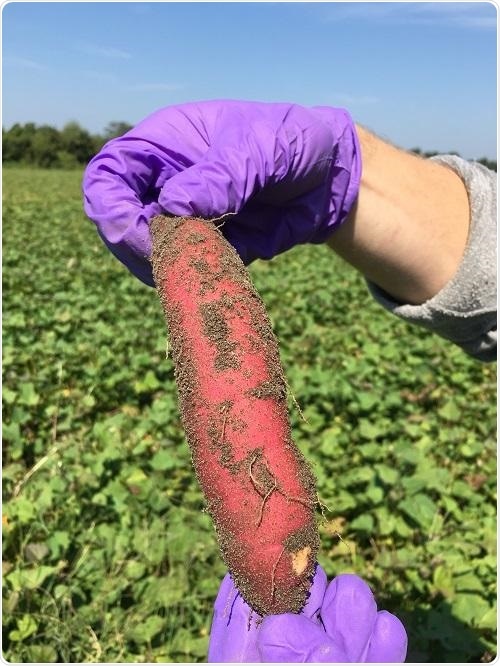Sweet potatoes are cultivated worldwide and are considered a major source of nutrition, especially in Asian and sub-Saharan African diets.
They are particularly vital to sub-Saharan Africa as a source of Vitamin A, a commonly deficient nutrient in this region.

Sweet potato and rhizospheric soil. Image Credit: Brooke Bissinger
Country-wise, China is the largest producer of sweet potatoes, but Sub-Saharan Africa has more land earmarked for the cultivation of sweet potatoes and continues to expand production.
Elsewhere, farmers are also growing sweet potatoes more and more. But in spite of the significance of sweet potatoes, not much is known about the microbiome of sweet potatoes.
A plant’s microbiome profoundly impacts its health and development. We sought to better understand the sweet potato microbiomes by characterizing it within and between actual working farms.”
Brooke Bissinger, Entomologist, American Phytopathological Society
The study on sweet potatoes was recently published in Phytobiomes Journal.
Bissinger and her collaborators work for AgBiome, which is financially supported by the Bill & Melinda Gates Foundation to discover and design beneficial microbes that would guard the sweet potatoes against insects in the developing world.
They made use of this opportunity to define the sweet potato microbiome to inform their project and offer data for other scientists focused on a similar study.
The researchers found that just like more commonly studied crops, the sweet potato microbiome follows the dual-step model of development.
We demonstrated a striking variability in the microorganisms that make up the sweet potato microbiome across a single farm. Despite this variability, we found commonalities in how the microbiome develops across fields within a single sweet potato farm and across two farms in the same region.”
Charles Pepe-Ranney, Study Lead Author and Microbial Genomics Data Scientist, American Phytopathological Society
This study was the first to define the sweet potato microbiome using the latest, next-generation sequencing technology, a crucial first step towards manipulating the microbiome to enhance the yield of sweet potatoes.
Also of note, our study suggests that the sweet potato presents a strong ecological challenge to its endophytes (microbes that live inside a plant). If we are going to develop a sweet potato endophyte that protects sweet potatoes from pests, for example, this sweet potato-beneficial endophyte must be able to withstand the strong ecological pressure from the sweet potato itself.”
Charles Pepe-Ranney, Study Lead Author and Microbial Genomics Data Scientist, American Phytopathological Society
Source:
Journal reference:
Pepe-Ranney, C., et al. (2020) Surveying the Sweet potato Rhizosphere, Endophyte, and Surrounding Soil Microbiomes at Two North Carolina Farms Reveals Underpinnings of Sweet potato Microbiome Community Assembly. Phytobiomes Journal. doi.org/10.1094/PBIOMES-07-19-0038-R.